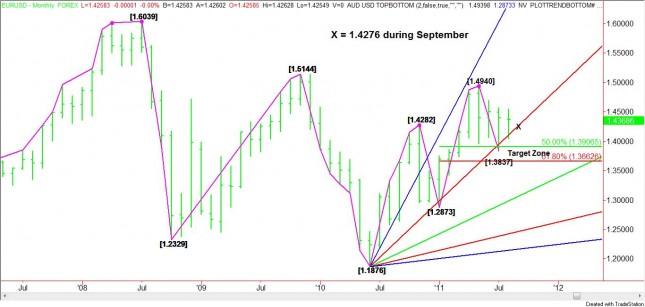 The EUR USD finished August virtually unchanged from July at 1.4369. The range for the month was .0494 which was relatively tight. In addition the Euro posted an inside move which typically indicates indecision and impending volatility.
The EUR USD finished August virtually unchanged from July at 1.4369. The range for the month was .0494 which was relatively tight. In addition the Euro posted an inside move which typically indicates indecision and impending volatility.
The inside trading range was most likely the result of uncertainty regarding the sovereign debt situation in many Euro Zone countries namely –Spain,Italy and Greece. The list could go on to include Ireland and Portugal, but last month the market seemed to focus on the big three.
The problems in the Euro Zone that are primarily weighing on the Euro center around creating a super fund to bailout the struggling nations, and the possibility of a double-dip recession. Throughout the month the debate raged on over how to bolster the European Financial Stability Facility fund. The debate was clearly a battle between the haves and the have nots. Understandably the richer nations are hesitant about throwing more money into a fund to bailout the poorer nations unless the latter continues to apply strict austerity measures to gain control of their finances.
This discussion is expected to continue until a final solution is reached. At times it was discussed in the news whether the Euro Zone was on the brink of a break up. When this alternative was proved to be too expensive, the thought of a Euro Bond was also mentioned. Unlike the U.S. Treasury, the European Central Bank may have a difficult time getting approval for such a proposal because of the many cultural, political and economic differences between the member nations.
The Italian debt market was also at the forefront last month. The cost of insuring Italian debt soared at times along with borrowing rates. When the situation reached a dangerous level, the ECB stepped in to buy Italian bonds. This helped put in the bottom in the Euro for the month until late August when traders began to focus on the economy.
The last week of August proved to be a tumultuous week for the Euro. What started out to be a near-term breakout above 1.4500 because of increased demand for higher yielding assets, turned ugly when ECB President Jean-Claude Trichet hinted that the central bank was considering ending its tight monetary policy. Whether he meant that interest rates hikes would come to an end or there would be a rate cut was unclear, but by the end of the month, it became clear that he must have had a peek at the economic numbers.
Facing both the possibility of a double-dip recession and the lingering sovereign debt crisis, the EUR USD begins September under pressure. Technically, the monthly chart indicates the market is in an uptrend. The charts show the main range is 1.2873 to 1.4940. The 50 percent to 61.8 percent retracement zone of this range at 1.3907 to 1.3663 may be the next downside objective.
At the start of the new month, the EUR USD was holding above an uptrending Gann angle at 1.4276. From the chart you can see that this angle started from the June 2010 bottom at 1.1876 and was tested successfully in January 2011 at 1.2873. This angle will clearly control the direction of the market in September. A break under 1.4276 will likely mean further downside pressure while holding this level may mean the market will take another shot at 1.4500.